Fluid Mechanics and Flow Physics
A range of fluid mechanics phenomena are being studied within the Department using both experimental and computational techniques. Prof. Jaywant Arakeri and his group has been actively carrying out experimental research in turbulent natural convection since the late 1980s. His activities have now been diversified into applied areas such as precision agriculture in protected environments. The experimental capability of the fluid mechanics team was enhanced after the joining of Prof. R.N. Govardhan in the early 2000s. His areas of interest include drag reduction, interaction of vortex with bubbles, turbomachinery flutter and shock boundary layer interactions. The computational strength of the fluid mechanics group was enhanced after Prof. Ratnesh K. Shukla and Prof. Gaurav Tomar joined the faculty. Together, they cover a wide range of topics in computational fluid dynamics (CFD) involving multiscale, multiphase and complex non-Newtonian flows. Prof. Aloke Kumar has recently joined this group, introducing the relatively nascent area of complex fluids.
The experimental and computational teams are now collaborating on a number of difficult and interesting fluid dynamics problems such as optimal surface actuation for drag reduction, thrust from rigid/flexible flapping foils for ‘robotic fish’, and biofluid mechanics involving flexible surfaces and unsteady boundary layers. A brief account of some of the exciting developments that have resulted is summarized below, with the topics being roughly ordered in decreasing order of interest – starting from turbulent convection at the geophysical scale to multi-scale simulations using molecular dynamics at the atomic/molecular level.
Turbulent Convection
Rayleigh Benard convection has been extensively studied as it forms the prototype for natural convection over heated horizontal surfaces, such as those found in the atmosphere and in the oceans and in many engineering systems. The near-wall flow dynamics are crucial for determining the heat transfer rate. A new plume-based model has been developed that allows calculation of near-wall turbulence parameters. New turbulence models can be developed for use in more complicated situations like evaporation over oceans. In the earth’s mantle the convection is at large scales and very viscous, i.e., the Rayleigh number (Ra) and Prandtl number (Pr) are very large. A novel met hod has been proposed to simulate high Pr, high Ra turbulent convection using salt instead of heat in laboratory-sized setups. A major advance has been the discovery of a new type of convective flow: axially homogeneous, purely buoyancy-driven turbulence driven by a linear density gradient in a long vertical tube. Apart from axial homogeneity, the flow has several unique features: very high heat fluxes and turbulence Reynolds numbers compared to Rayleigh Benard convection, and achievement of so called ‘ultimate regime’ so far not observed in experiments or simulations.
A major unanswered question is how tiny droplets in a cloud grow in size to produce eventual precipitation. It is believed that turbulence in the clouds is crucial for the growth, but the mechanism is unknown. Experiments have been initiated using the axially homogeneous turbulent convective flow in the presence of moisture to mimic condensation and droplet growth in actual clouds. This work is being done in collaboration with Indian Institute of Tropical Meteorology and is expected to give insights for better modeling of cloud processes.
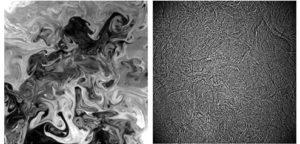
Turbulent convection: Dye visualization (left) and shadowgraph picture (right) of turbulence in a long vertical tube.
Precision agriculture in protected environments
Precision agriculture – providing optimum amounts of water and nutrients at the right times – requires close interaction between agricultural and engineering scientists, which is largely missing in India. In collaboration with University of Agricultural Sciences, Jawaharlal Nehru Centre for Advanced Scientific Research and Mechanical Engineering, IISc, two projects have been initiated – precision farming model for peri-urban agriculture, and aeroponics for mini-tuber cultivation. Important aspects of work are the study of moisture loss from plants and soils, and the maintenance of optimum climatic conditions in protected environments such as green houses. Several new technologies have been developed including a new type of solar-chimney based greenhouse suitable for Indian climatic conditions, leaf mimic for assessing local transpiration rates, and an efficient aeroponics system.
Though evaporation from soils and other porous media has been extensively studied, many of the crucial processes are not understood. Controlled IR heating (not done before) and three diagnostics – evaporation rate measurement, IR imaging and fluoroscene dye visualization – simultaneously revealed new insights, in particular transition to the second stage of evaporation. Broadening the definition of a porous medium, evaporation from nonconventional porous media – packed rods, packed plates – was examined to yield unexpected results. In particular, vertically packed rods offer ‘infinite’ capillary rise heights giving high heat fluxes compared to conventional porous medium. This feature makes it attractive for use in heat pipes, and a patent has been applied for.
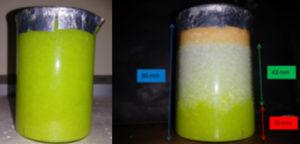
Evaporation from a porous medium heated from the top. Fluorescein dye (left) added to the initially saturated medium shows a green colour. At the end of the experiment (right) the top orange layer shows dye deposition, the middle white layer is drained of water and the bottom green layer is saturated.
Interaction of flows with bubbles: Towards drag reduction
There has been a lot of recent interest in reducing drag on surfaces (immersed in water) using bubbles with potential applications ranging from drag reduction of underwater vehicles to pressure-drop reduction in liquid pipelines. This includes primarily two broad methods, one utilizing ‘textured hydrophobic’ surfaces, and the other is injecting small bubbles from the surface into the flow.
In the approach using injected bubbles, drag reduction can either be caused by direct modification of fluid properties like density and viscosity, or through the relatively more complex interaction of bubbles with turbulent structures within the boundary layer. To understand this latter interaction, we have investigated an idealization of this problem, namely the interaction of a single bubble with a vortex ring formed in the continuous phase (water) with measurements of both the bubble dynamics and vorticity dynamics to help understand the two-way coupling. We have also studied actual drag reduction in a turbulent channel flow by the injection of bubbles with results showing that there exist many different regimes of bubble dynamics in the flow depending on th e rate of bubble injection and the channel Reynolds numbers. The measured drag is found to be greatly dependent on the bubble dynamics regime with possibilities of both enhanced drag and reduced drag compared to the reference no-bubble case.
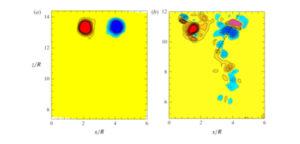
Comparison of azimuthal vorticity distribution for a vortex ring with (a) and without (b) interactions with a bubble (We=3). The bubble is marked by hatched line filled with magenta colour, while the solid and dashed line contours represent positive and negative signs of vorticity, respectively.
In contrast to the injection of bubbles, another mechanism for drag reduction is the use of textured hydrophobic surfaces as channel walls. The ability of these surfaces to provide substantial drag reduction has been attributed to the presence of air bubbles trapped on the surface cavities. However, this drag reduction cannot be sustained due to gradual dissolution of trapped air into water. In our recent work, we have explored the possibility of sustaining the underwater Cassie state of wetting in a microchannel by controlling the solubility of air in water; the solubility being changed by controlling the local absolute pressure near the surface.
Transonic/supersonic flows: turbomachinery flutter and shock boundary layer interactions
In aircraft engine applications, the first-compressor stages operate at transonic conditions, thus necessitating the use of sharp thin blades, which are prone to stall flutter at off-design conditions. Motivated by this problem, we have set-up a high-speed transonic cascade facility, where we can study flow through a linear cascade of blades at transonic conditions at a Mach number of about 1.3.
 Flutter of compressor blades at transonic conditions. The blowdown transonic tunnel can achieve stable Mach 1.3 flow through the use of porous walled test-section (left). Shadowgraph of the flow through a linear cascade placed within the test-section (right).
Flutter of compressor blades at transonic conditions. The blowdown transonic tunnel can achieve stable Mach 1.3 flow through the use of porous walled test-section (left). Shadowgraph of the flow through a linear cascade placed within the test-section (right).
The blades in this cascade can be forcibly oscillated at realistic reduced frequencies corresponding to large dimensional frequencies of about 250 Hz. This employs a high-speed oscillation mechanism driven by a specially made barrel-cam assembly. The unsteady load on the oscillating blade can be measured to calculate energy transfer to the blades from the flow, and the tunnel is also compatible with PIV for flow field measurements. A shadowgraph of the flow through a transonic cascade is shown in the figure. It shows the passage shock emanating from the leading edge of the blade, and the trailing edge shock system. An important result from our measurements here is the key role played by the cycle-averaged location of the passage shock between the compressor blades. A few other problems of high speed nature including flow through a rotating radial cascade, shock-boundary layer experiments over a forward-facing step, and jet in supersonic flow have also been and continue to be investigated.
Optimal surface actuation for drag reduction
Jaywant Arakeri & Ratnesh Shukla
The focus of our research work on drag reduction has been on determining optimal surface actuation-based flow control strategies that minimize net power consumption while effectively reducing the hydrodynamic loads in bluff body flows. This unique focus distinguishes our investigations from prior works, an overwhelmingly vast majority of which, while targeting a net reduction in drag, do not consider the energetic efficiency of the control strategy. From a practical standpoint, an evaluation of the energetic cost of controlling the flow is of utmost importance as the net power expended in achieving a reduction in drag determines the failure or success of a given flow control strategy.
Through an energy budget analysis, we have introduced a power loss coefficient as a universal metric of performance for quantification of the energetic cost of enabling drag reduction, self-propulsion or thrust production in general bluff body flows. Subsequently, considering the power input requirements of the tangential surface velocity and wall-normal blowing and suction controllers, we have determined the optimal profiles that enable flow control on a circular cylinder with striking efficacy. This also ensures reduction of both drag and net power consumption remarkably over a wide range of Reynolds numbers.
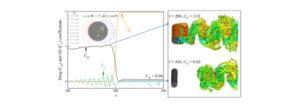
Application of surface-normal wall transpiration results in a remarkable decrease in the hydrodynamic loads on a translating circular cylinder. Left panel indicates drag and lift coefficients as a function of time. Right panels depict the reduction in the generation and advection of vortical structures.
Thrust from rigid/flexible flapping foils for ‘robotic fish’
Jaywant Arakeri, Ratnesh Shukla & R.N. Govardhan
Unsteady thrust generation from foils that undergo time-periodic undulatory motions is of interest for the development of new bio-inspired thrust generation systems for autonomous underwater vehicles (AUVs) or “robotic fish”. There have been both experimental and computational studies within the Department to investigate the propulsive performance of such oscillating rigid and flexible foils. On the computational side, high-resolution simulations are performed using a GPU-accelerated Lagrangian viscous vortex particle method developed specifically for fluid motion over arbitrary deforming bodies. These simulations have revealed the existence of a sharp transition in the peak propulsive performance of pitching foils as the Reynolds number (Re) is decreased from large values. Through a systematic evaluation of the energetic cost of thrust production over a vast parametric space, we have established the range of Re over which pitching foils produce thrust with no significant deterioration in propulsive efficiency. These results are of significance because of the continued thrust towards further miniaturization of small-sized unmanned and micro air vehicles (UAVs and MAVs) and AUVs. On the experimental side, one of the focus points has been the effect of flexibility of the tail fin on its propulsive performance. By nature, most biological materials are inherently flexible and the effect of this flexibility on the propulsive performance can be quite substantial. Experiments have shown that there are two different optimal stiffnesses (or flexibility), one for maximum thrus t, and another for maximum efficiency with correspondingly different flap deflection profiles. At both these optimal conditions, the corresponding thrust and efficiency are significantly larger than the rigid foil case. We also discovered that a foil with a flexible flap pitching in still fluid produces a coherent jet, which may be used in cooling of electronic equipment and to produce hovering motion in MAVs. These results will be useful for the design of robotic fish, and this is now planned as a multi-disciplinary and multi-institutional project.

(Left) Different wake patterns (2P, 2P+2S, 2P+2S2, 4P and 4P+2S from left to right, where S and P denote a single vortex and counter rotating vortex pair respectively). (Right) Flexible flap deflection profiles close to (a) the maximum thrust condition and (b) the maximum efficiency condition for a pitching rigid foil with a flexible trailing edge flap. The profiles are shown on the left, while three instants of the full foil are shown on the right. T is the oscillation time period.
Biofluid mechanics: Starting flows with flexible surfaces and unsteady boundary layers
Jaywant Arakeri & R.N. Govardhan
We have been studying the effects of surface flexibility motivated by biological systems, whose surfaces (tissues/membranes) are inherently flexible. In this connection, we have studied starting flows from channels/pipes with flexible exits, motivated by biological systems like heart valves and the propulsive action of some aquatic creatures (such as the jellyfish) that are composed of flexible membranes. In these cases, the flexural exit’s stiffness becomes an important parameter.
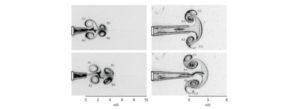
Flow visualization sequences for starting flow with two different lengths of flexibly mounted flaps at the nozzle exit. The two images on the left correspond to flap length that is twice the nozzle exit (Lf/d = 2), while the two images on the right correspond to
Lf/d = 4.
The experimental arrangement used in these cases is a starting flow through a channel/pipe generated by a computer-controlled piston, and the resulting starting flow field is visualized simultaneously with the deformations of the flexible end. In the flexible exit cases, additional pairs of vortices are formed, resulting in a distinctly different distribution of vorticity compared to the no-flaps rigid base case. Interestingly, the total final circulation remained almost the same as that of a rigid exit case, for different types of flexible ends. However, the final fluid impulse was always higher in the flap cases as compared to the rigid exit case because of vorticity redistribution. Since the time rate of change of impulse is linked with force, the measurements suggest that introduction of flexible flaps at the exit could result in better thrust performances if looked at from a propulsion point of view. Extensive work has also been done with such unsteady starting flows in rigid and curved surfaces in an unsteady flow facility. This led to the framing of criteria for transition to turbulence and separation for unsteady boundary layers. Recently, scaling laws have been proposed for unsteady flows in curved tubes, which will be important for endothelial cell response in arteries.
Simulations of high-speed multiphase compressible flows
Our investigations in the area of high-speed multiphase compressible flows are primarily concerned with the impulsive motion and jetting dynamics of collapsing bubbles in free space and in confinement. These computational investigations have been enabled by our high-fidelity shock- and interface-capturing simulation tools that we have developed recently. A distinguishing feature of our interface capturing methodology is its ability to resolve intricate interfacial features crisply while enforcing the critical requirement of oscillation-free transport of the material interface. Meeting these two requirements that are directly linked to accuracy and robustness of the discretization is a formidable challenge and most simulation methods for shock-driven multiphase flows forgo one over the other. To overcome the dual challenges of achieving high accuracy and maintaining robustness, we have formulated a novel nonlinear transformation technique that utilizes a map from the smooth signed distance function to a steep mesh-resolved hyperbolic tangent interface function. In contrast to the standard shock and interface capturing treatments, our technique eliminates the progressive loss in the resolution of the material interface by restricting the artificial increase in its width. We have shown that our interface-capturing technique leads to exceptionally detailed resolution of material interfaces in simulations of single and multi-bubble collapse processes and retains its accuracy for relatively large density and pressure contrasts alongside strong shocks and large variations in equations of state. Utilizing this flow solver, we have made important progress in the understanding of bubble-bubble interactions in multi-bubble setups by quantifying the extent to which an upstream bubble can suppress an otherwise strong shock-induced jetting of the downstream bubbles. In particular, we have shown that the presence of an upstream bubble suppresses the otherwise strong jetting dynamics and, under certain conditions, leads to formation of a counterjet. We have also shown that the altered jetting dynamics has a profound impact on the damage potential of collapsing bubbles.

Shock-induced collapse and jetting of two air bubbles in water next to a rigid wall. Left frames depict the incident and reflected shocks and the strong blast waves that are produced due to the collapses of the two bubbles. Right frame depicts the maximum pressure experienced by the rigid wall as a function of time.
Drop and Bubble Dynamics in Electric Field
In various chemical engineering applications, such as bubble column reactors, inkjet printers, sprays and combustion systems, bubbles and drops of smaller sizes are desired for efficient heat and mass transfer. The size of the bubbles, forming at needles and orifices at low flow rates, depends essentially on buoyancy and surface tension forces. Similarly, formation of drops in spray applications depends essentially on the liquid injection rates and surface ten sion forces. Thus, externally applied forces, such as vibrational or electric and magnetic forces, are employed for control of the bubble and drop formation processes. Electric field has been known to reduce the size of the bubbles in bubble injection systems and has also been employed in inkjet printing and electrospraying to generate mono-dispersed droplets.

(Left) Axisymmetric simulations of bubble formation at a needle in the presence of electric field.
(Right) Non-coalescence of conducting drops: Oppositely charged drops initially approach each other in electric field; after initial contact and exchange of charge, they repel each other.
We have performed axisymmetric simulations of the bubble injection process to study the effect of electrode configuration. We showed that the bubble size could be controlled further by generating a non-uniform electric field around the bubble using certain electrode configurations. In this study, we have also discovered a new phenomenon involving electric stress induced pinning-depinning of the needle contact line that leads to the reduction in the bubble volume in the presence of non-uniform electric fields. Our simulations of interactions between drops of conducting fluids in a perfectly dielectric ambient fluid capture the interesting phenomenon of non-coalescence of drops above a certain critical strength of electric field.
Atomization of a liquid jet in a crossflow
In many applications such as spray systems in drug delivery, cosmetics and fuel injection systems in IC engines and gas turbines, very small droplet sizes are desired to provide a larger surface-to-volume ratio. In gas turbines, it is desirable to have small droplets for efficient fuel combustion. In most numerical studies, droplets from the primary atomization are assumed to follow a particular PDF distribution to predict further break-up based on correlations. This yields highly approximate estimates of the distribution of drop sizes at the end of the complete atomization process. We perform 3D numerical simulations of primary atomization of a liquid jet in a crossflow of air to study the effect of various parameters involved. In particular, we focus on the effect of swirl in the crossflow on the break-up and subsequent spreading of the droplets. Further, we also numerically studied secondary break-up of a drop for different Weber numbers (We) and compared with experimental results.These are the first simulations of high-density ratio two-phase flow capturing all the regimes of aerodynamic breakup of droplets for experimentally observed We values. We also explored possible mechanisms that lead to the interesting changes in the drop morphology and subsequent break-up with increasing We such as bag formation, bag-with-stamen and multi-lobed bags.

Fragmentation of a liquid drop in a gas flow (density ratio ~1000) at a Weber number of 40. All the essential features of breakup, namely, bag rupture and node and stamen formation, observed in experiments have been captured in the numerical simulations.
Flows of complex fluids
The focus of research has been to understand flows and material behavior in the context of environmental situations. One example is the design of a microfluidic device with an array of micropillars , motivated by the need to understand flows of fluid in porous media. The micropillar array serves as obstacles, which mimic the tortuous path a fluid particle has to take in a real porous media (e.g. soil). Flows in such situations occur in many environmental and industrial situations such as drainage through soil, oil extraction processes, large scale filtration, etc.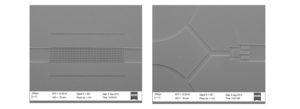
Microfluidic device mimicking porous media – a set of pillars serve as obstacles to the flow mimicking the tortuous path taken by fluids in porous media. Figure shows inlet of device (left) and micro-pillar array (right).
In the context of water purification, we study particle-laden flows in microfluidic/microscale systems to better understand how membrane processes are affected by particulate matter. Another topic of interest is the flow of complex fluids, which include shear-thinning and shear-thickening fluids. These fluids are crucial in several industrial contexts and many aspects of their flows still need better understanding.
Multiscale simulations
Ratnesh K. Shukla & Gaurav Tomar
Multiscale modeling is an active area of research due to the dependence of several new-generation technologies (micro- and nano-fluids) on phenomena that cut across various length and time scales. Multiscale phenomena can be categorized into (a) globally multiscale such as in polymeric flows where the flow affects the microscopic arrangement of polymer molecules, which in turn modifies the response of t he fluid to the flow (b) locally multiscale such as those involving interfacial phenomena and shock formation, and (c) local breakdown of continuum such as those in corner flows. Recently, we have developed numerical codes based on multiscale algorithms to couple molecular dynamics with continuum flow solvers using appropriate boundary conditions derived from each of these scales. Using the multiscale coupling algorithm, we worked on the resolution of the corner singularity in a lid-driven cavity flow.
We are also developing a multiscale strategy to study droplet interaction with substrate. A thin-film parallel solver to capture the dynamics of the air trapped between the drop and the substrate has been developed. The dynamics of the air film determines the nature of drop-substrate interaction. If the drainage or rupture of the film takes longer than the capillary relaxation time of the drop, the drop may rebound without any contact with the substrate. This study has applications in self-cleaning surfaces and spray cooling.
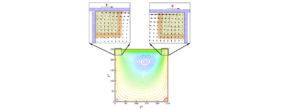
Singularity in the lid-driven cavity flow (Re = 50) resolved using multiscale simulations. Flow in the vicinity of the corners is simulated using molecular dynamics.
